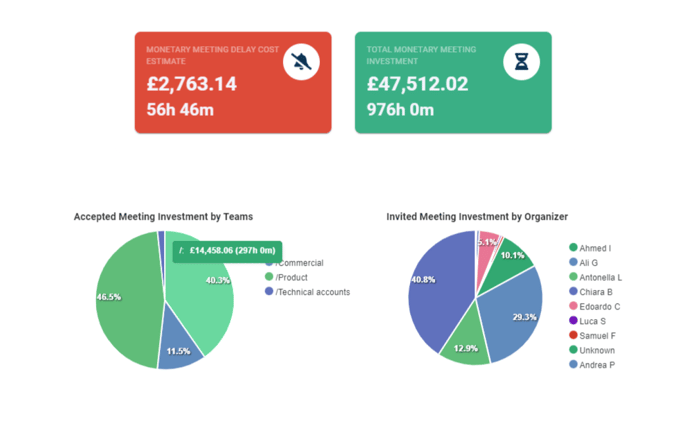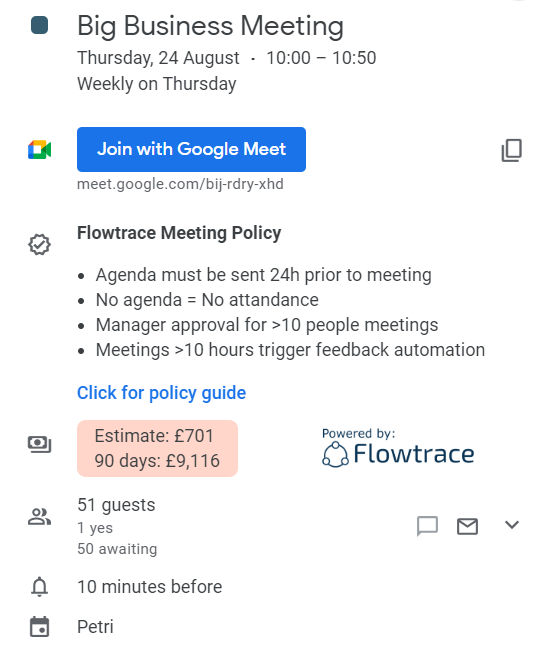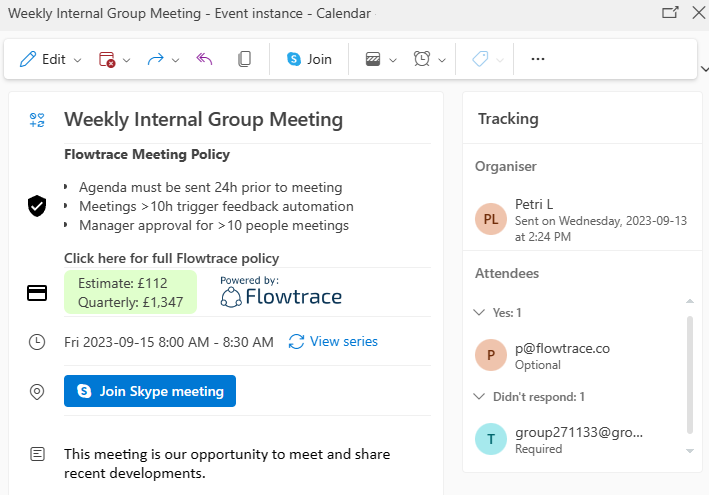Utilizing Google Calendar Analysis Software
Learn how Google Calendar analysis can optimize organizational efficiency by identifying scheduling inefficiencies and improving meeting practices.
Benefits of calendar analysis include 20% reduction of meeting time, enhanced organizational productivity and efficiency. Read to boost team performance.
In any organization, calendar analysis is an essential tool for leaders seeking to drive efficiency and productivity amongst teams. This strategic practice delves into the intricacies of scheduling to identify patterns, inefficiencies, and opportunities for optimization of meeting culture. By implementing calendar analysis, leaders can transform how time is managed and utilized, ensuring that every hour contributes to more efficient teams and cost savings across the organization. We are going to take a look at some of the benefits of calendar analysis and strategies for effective calendar management.
Calendar analysis, in the context of organizational productivity, is a critical tool that helps leaders make the most out of not only their own time but teams within the organization. In today's fast-paced business environment, effective time management is essential for efficiency and productivity. Calendar analysis provides an in-depth look into how time is allocated within an organization, identifying patterns and inefficiencies that might otherwise go unnoticed.
For instance, a study by the Harvard Business Review found that the average manager spends up to 50% of their time in meetings, many of which are unproductive. By conducting a thorough calendar analysis, meeting schedulers can significantly cut down on unnecessary meetings, freeing up substantial time for more productive activities and deep work time. This not only enhances individual productivity but also has a ripple effect across teams and departments, leading to overall organizational efficiency.

Calendar analysis helps in identifying time spent on low-value tasks, enabling managers to redirect efforts toward high-impact activities. This strategic realignment of time and resources can lead to:
The benefits of calendar analysis in boosting organizational productivity allow for a more strategic allocation of time, reduce time wasted on non-essential tasks, and align employee efforts with the organization’s broader objectives. Companies can not only improve their operational efficiency but also foster a culture of productivity and purposeful work.
Calendar analysis plays a key role in enhancing team efficiency and performance. By analyzing how teams allocate their time, managers can identify and eliminate bottlenecks, streamline workflows, and ensure that every team member's time is used effectively. For example, On average a single distraction wastes 4.8% of the workday. This analysis often reveals hidden time sinks, such as prolonged meetings or repetitive administrative tasks, allowing for a reallocation of efforts to more critical areas.

The impact of this not only improves the efficiency of individual team members but also enhances the collective output. Teams that spend less time in unnecessary meetings have more time for collaborative, deep work, driving innovation and project completion. Furthermore, calendar analysis can help in synchronizing team schedules, ensuring that collaboration happens seamlessly, and project milestones are met efficiently.
Effective calendar management, guided by thorough analysis, leads to:
The result is a team that operates like a well-oiled machine, with each member playing their part in achieving the organization's goals in a timely and effective manner.
Another key calendar analysis benefit is identifying and reducing time spent in non-essential meetings, a common inefficiency in many organizations. By thoroughly examining calendar data, managers can pinpoint meetings that are either redundant, overly frequent, or involve too many participants without significant contributions. This analysis often reveals a pattern of meetings that could be consolidated, shortened, or even replaced with more efficient communication methods, such as email or quick team huddles.
The reduction of unnecessary meetings has a direct impact on team productivity. It frees up substantial amounts of time, allowing team members to focus on tasks that directly contribute to the organization's goals. Additionally, fewer meetings can lead to a decrease in employee fatigue and an increase in job satisfaction, as team members feel their time is being used more effectively.

Calendar analysis provides a clear framework for evaluating the necessity and effectiveness of meetings. By applying these insights, organizations can cultivate a meeting culture with purposeful and efficient communication, where meetings are only held when they are the best means to achieve a specific objective.
This disciplined approach to scheduling not only enhances the productivity of individual team members but also contributes to the overall operational efficiency of the organization.
One of the main benefits of calendar analysis is that it significantly contributes to maximizing deep work time, a concept crucial for high-level cognitive tasks and creative problem-solving. By analyzing calendar data, organizations can identify periods consistently interrupted by meetings or other fragmented activities. This information allows for the restructuring of schedules to create blocks of uninterrupted time, essential for deep work.
Deep work requires concentration and focus, which are often disrupted in a typical workday filled with back-to-back meetings and immediate task responses. By strategically scheduling meetings and other collaborative activities, calendar analysis helps carve out dedicated periods for deep work. These uninterrupted sessions enable employees to engage in complex tasks without the frequent breaks in concentration caused by shifting to meetings or other less intensive tasks.

Also, calendar analysis can help in setting specific times for deep work, considering factors like individual peak productivity hours and team collaboration needs. For example, mornings might be reserved for deep work, while afternoons are allocated for meetings and collaborative tasks. This structured approach ensures that employees have the time and mental space to engage in deep, meaningful work, ultimately leading to more innovative solutions and higher-quality outputs.
Efficient scheduling through calendar analysis is a powerful tool for increasing opportunities for deep work. By allocating dedicated time for intensive, focused work, managers can enhance their employees' ability to tackle complex problems, innovate, and produce high-quality work.
Effective calendar management, utilizing calendar analysis, has significant financial implications and offers a substantial return on investment (ROI) for organizations. By optimizing meeting schedules and increasing time for deep work, companies can see a marked improvement in employee productivity, which directly translates to financial benefits.
For instance, reducing unnecessary meetings through calendar analysis not only saves hours that can be redirected to revenue-generating activities but also decreases the indirect costs associated with unproductive time. Studies have shown that poorly managed meetings can lead to substantial financial losses annually. By streamlining meetings, companies can recover a significant portion of this lost value.

Additionally, the increased opportunity for deep work results in higher-quality outputs and innovations, which can drive business growth and revenue. This improvement in work quality can lead to better client satisfaction, increased sales, and a stronger market position, further enhancing the financial return.
The ROI from effective calendar management is multifaceted, encompassing direct savings from reduced wasteful meetings, gains from increased productivity, and the long-term financial benefits of improved work quality and innovation. For organizations looking to enhance their operational efficiency and financial performance, investing in effective calendar management strategies is a key decision.
Real-world success stories illustrate the transformative power of calendar analysis in enhancing organizational efficiency.
Microsoft, for instance, developed a solution within its Productivity Studio to help executives take control of their calendars by analyzing how they spend their time, leading to more strategic decision-making and a more profound impact on the organization.
This involved categorizing calendar data to provide insights into time allocation, enabling leaders to prioritize their activities more effectively and focus on areas more impactful to team and organizational goals. These examples underscore the tangible benefits that calendar analysis can deliver in a corporate setting.
The Shopify Meeting Cost Calculator, as a Chrome extension built into Google Calendar, provided their 11,000-plus global employees with visibility into the estimated costs of their meetings.
It was found that an average 30-minute meeting with three employees costs between $700-$1600. Shopify anticipated a 15% reduction in overall costs by eliminating just three such meetings per week per person.
This tool was part of a broader initiative to reduce unnecessary meetings and promote more efficient time use, reinforcing the need to reconsider meeting necessity and explore creative collaboration methods.
In an era where time is a critical asset, leaders must leverage every tool at their disposal to enhance productivity and decision-making. Calendar analysis, combined with Flowtrace Analytics is one powerful tool, with a look into how time is allocated and utilized within an organization.
Here are actionable strategies for leaders to implement calendar analysis effectively:
By integrating these strategies with the advanced capabilities of Flowtrace, leaders can transform raw data into a strategic asset, optimizing how time is spent and enhancing overall organizational efficiency. Remember, effective calendar analysis is not just about understanding current patterns, it's about using those insights to drive meaningful change and achieve strategic objectives.
The implementation of calendar analysis demonstrates a commitment to efficiency, productivity, and strategic focus. By understanding how time is spent, leaders can make informed decisions to enhance productivity, streamline processes, and foster a culture of effectiveness.
Calendar analysis allows leaders to identify and address inefficiencies, such as prolonged or unnecessary meetings, while highlighting opportunities for deep, focused work. It empowers teams to prioritize tasks that align with overarching goals, ensuring that every minute is invested towards driving organizational success. Adopting Flowtrace’s analytics can improve your calendar analysis exponentially and set the standard for an effective meeting culture.
Learn how Google Calendar analysis can optimize organizational efficiency by identifying scheduling inefficiencies and improving meeting practices.
Optimize your meetings with a Google Calendar Dashboard and Flowtrace integration. Gain actionable insights into time usage, meeting costs, and...
Improve efficiency, reduce costs, and make smarter decisions with a meeting cost calculator. Understand the financial implications and optimize...